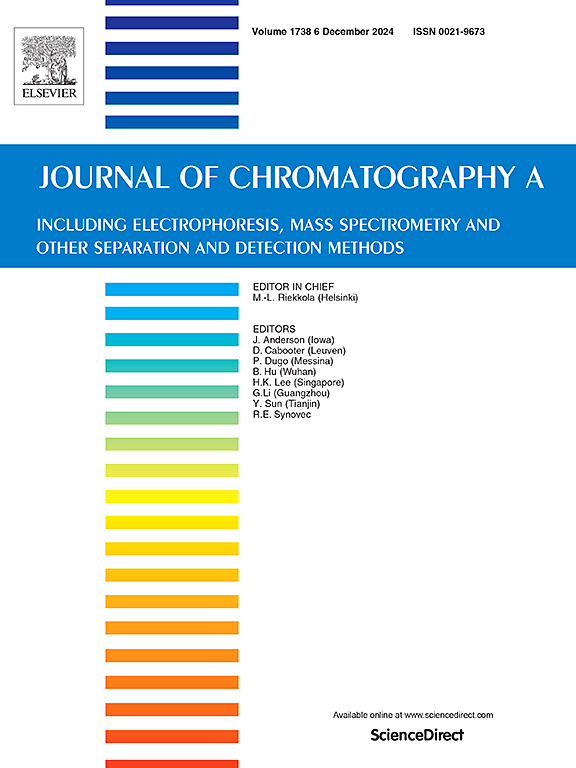Enhanced by ionic liquids: Magnetic molecularly imprinted polymers-magnetic solid-phase extraction-UHPLC-UV for sensitive detection of benzimidazoles in multiple food matrices
IF 4
2区 化学
Q1 BIOCHEMICAL RESEARCH METHODS
引用次数: 0
Abstract
Benzimidazoles (BZDs) as fungicides and veterinary drugs may remain in various food matrices, posing potential risks to human health. It is challenging to detect trace BZDs under complex matrix interferences. In this study, ion liquid magnetic molecularly imprinted polymers (IL-MMIPs) for the selective extraction of six BZDs from complex matrices were synthesized via surface imprinting technology with vinyl-functionalized Fe₃O₄@SiO₂ as magnetic carriers. Importantly, the synthesized 1-vinyl-3-amidomethylimidazolium chloride ([VAFMIM]Cl-IL) was used as the functional monomer, which could form π-π, hydrogen bonds, electrostatic interactions, ion exchange, and hydrophobic interactions with BZDs. A series of adsorption test results demonstrated that IL-MMIPs exhibited superior selectivity, with high imprinting factors (3.77–4.41) and excellent adsorption capacities (18.26 mg/g). Furthermore, coupling with ultra-high performance liquid chromatography (UHPLC) analysis, an effective, sensitive and selective analysis method based on IL-MMIPs-MSPE-UHPLC integrated technology was established and validated for the quantification of 6 BZDs from multiple food matrices. The results showed remarkable sensitivity with limits of quantification 1.5–10.0 μg/kg and expected recoveries (85.1 %-103.6 %). The method satisfied the detection standards of China and the European Union (EU) and had been applied to food matrices including pork, milk, eggs, drinking water, grapes, cucumbers samples. Finally, trace amounts of thiabendazole were detected only in grapes (533 μg/kg) and eggs (79 μg/kg), demonstrating practical significance for detecting trace BZDs in complex matrices.
离子液体增强:磁性分子印迹聚合物-磁性固相萃取- uhplc - uv对多种食品基质中苯并咪唑的灵敏检测
苯并咪唑(BZDs)作为杀菌剂和兽药可能残留在各种食物基质中,对人类健康构成潜在风险。在复杂矩阵干扰下检测痕量bzd是一项具有挑战性的工作。本研究以乙烯基功能化Fe₃O₄@SiO₂为磁性载体,采用表面印迹技术合成了离子液体磁性分子印迹聚合物(IL-MMIPs),用于从复杂基质中选择性提取6种BZDs。重要的是,合成的1-乙烯基-3-酰胺甲基咪唑氯([VAFMIM]Cl-IL)作为功能单体,可以与BZDs形成π-π、氢键、静电相互作用、离子交换和疏水相互作用。一系列吸附实验结果表明,IL-MMIPs具有较好的选择性,印迹因子较高(3.77 ~ 4.41),吸附量为18.26 mg/g。结合超高效液相色谱(UHPLC)分析,建立了一种基于IL-MMIPs-MSPE-UHPLC集成技术的高效、灵敏、选择性分析方法,用于多种食品基质中6种BZDs的定量分析。结果灵敏度高,定量限为1.5 ~ 10.0 μg/kg,加样回收率为85.1% ~ 103.6%。该方法符合中国和欧盟(EU)的检测标准,已应用于猪肉、牛奶、鸡蛋、饮用水、葡萄、黄瓜等食品基质样品的检测。最后,仅在葡萄(533 μg/kg)和鸡蛋(79 μg/kg)中检测到微量噻苯达唑,对复杂基质中痕量BZDs的检测具有实际意义。
本文章由计算机程序翻译,如有差异,请以英文原文为准。
求助全文
约1分钟内获得全文
求助全文
来源期刊

Journal of Chromatography A
化学-分析化学
CiteScore
7.90
自引率
14.60%
发文量
742
审稿时长
45 days
期刊介绍:
The Journal of Chromatography A provides a forum for the publication of original research and critical reviews on all aspects of fundamental and applied separation science. The scope of the journal includes chromatography and related techniques, electromigration techniques (e.g. electrophoresis, electrochromatography), hyphenated and other multi-dimensional techniques, sample preparation, and detection methods such as mass spectrometry. Contributions consist mainly of research papers dealing with the theory of separation methods, instrumental developments and analytical and preparative applications of general interest.
 求助内容:
求助内容: 应助结果提醒方式:
应助结果提醒方式:


